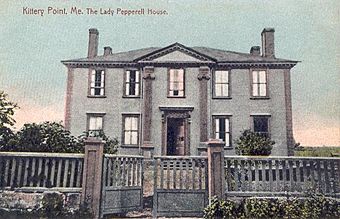Lady Pepperrell House facts for kids
|
Lady Pepperrell House
|
|
 |
|
| Location | Kittery Point, Maine |
|---|---|
| Area | less than one acre |
| Built | 1760 |
| Architectural style | Georgian |
| NRHP reference No. | 66000094 |
Quick facts for kids Significant dates |
|
| Added to NRHP | October 15, 1966 |
| Designated NHL | October 9, 1960 |
The Lady Pepperrell House is a very old and special home in Kittery Point, Maine. It was built way back in 1760. This beautiful house was made for Lady Mary Pepperrell, who was the wife of Sir William Pepperrell.
Sir William Pepperrell was a famous leader. He was the only American from the colonies to be given a special title called a "baronet" by King George II. This was because he led a successful mission in 1745 against the French Fortress of Louisbourg in Canada.
The Lady Pepperrell House is a great example of Georgian architecture. This style was popular a long time ago. Today, the house is a National Historic Landmark. This means it's a very important historical place. It is still owned by private people, but a group called Historic New England helps make sure it stays preserved.
Contents
What the House Looks Like
The Lady Pepperrell House is a two-story building made of wood. It has a special kind of roof called a hip roof and four chimneys. The front of the house has a part that sticks out a little. This part has tall, fancy columns called pilasters. They have special tops called Ionic capitals.
The main front door is in this sticking-out part. It also has fancy columns on each side. The corners of the house have a special design that looks like blocks.
There's a porch on the left side of the house. It was added in 1922 and matches the old style of the house. There used to be another matching porch on the right, but it's not there anymore. At the back of the house, there's a two-story section that was used as a kitchen.
Inside the Lady Pepperrell House
Inside, the house has a common layout for homes from that time. It has a big central hallway. On each side of the hall, there are two rooms. The rooms that were used for guests or important meetings have beautiful wooden decorations. This fancy woodwork has been kept in great condition over the years.
The Story of Lady Pepperrell
Lady Pepperrell was born Mary Hirst in 1704 in Boston, Massachusetts. Her father was a merchant, which means he bought and sold goods. In 1723, she married Captain William Pepperrell. He was also a merchant and owned a lot of land in what is now southern Maine. At that time, Maine was part of Massachusetts.
Mary and William lived in his family home in Kittery Point. William Pepperrell became very famous. He was chosen by Governor William Shirley to lead an important mission in 1745. This mission was to attack the French Fortress of Louisbourg.
Sir William Pepperrell was very successful in this mission. Because of his success, King George II gave him the special title of "baronet." This made him "Sir William Pepperrell." When Sir William died in 1759, he was one of the richest people in Massachusetts.
Building a New Home
After Sir William died, Lady Pepperrell decided to build a new house in 1760. She hired skilled English builders to make sure the house was built in the very popular Georgian style. This style was known for being grand and elegant.
Lady Pepperrell lived in this beautiful house until she passed away in 1789. After her death, the house had several different owners over the years. In 1942, the house was given to a group called the Society for the Preservation of New England Antiquities. This group is now known as Historic New England.
Historic New England carefully restored the house. They even opened it as a museum for people to visit. In 1985, the group sold the house to private owners. However, they made sure to keep special agreements in place. These agreements help protect the house and make sure its historic look is not changed too much.
The Lady Pepperrell House is still privately owned today. But it is sometimes open to the public for visits. It was named a National Historic Landmark in 1960. It was also added to the National Register of Historic Places in 1966.



